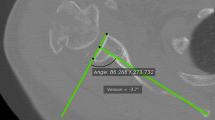Abstract
Purpose
To investigate the reproducibility of shoulder bony landmarks location using the EOS® low-dose stereoradiography system, in order to validate this new tool for the study of gleno-humeral pseudo-kinematics.
Methods
An inter and intraobserver reproducibility study of shoulder bony landmarks location concerning 22 healthy volunteers. This study concerned the neutral position, arm at rest. Humerus and scapula were modeled with simple geometric shapes using specific software. Those shapes were positioned on A-P and lateral x-rays views. Images analysis of the 22 subjects was carried out three times (n r = 3), by two observers (n o = 2), for a total of n tot = 132 analyses.
Results
We obtained a very good reproducibility for the humeral head center and the diaphysis axis with 95% confidence interval (IC95%) inferior to 1.09 mm and 0.41°, respectively. The uncertainty was higher for the lateral and medial epicondyles. Regarding the scapular bony landmarks, we observed a good reproducibility for the tip of the coracoid process, the inferior glenoid rim, and the axillar border with a 95% confidence interval lower than 2.13, 2.91 mm, and 3.67°, respectively. The uncertainty was higher for the most postero-lateral point of the acromion and the superior glenoid rim.
Conclusion
Our analysis of the x-rays obtained with the EOS® low-dose stereoradiography system assessed the location reliability and reproducibility of specific scapular and humeral bony landmarks. This work opens the way to gleno-humeral pseudo-kinematics analysis using EOS® imaging system.


Similar content being viewed by others
Notes
The EOS® imaging system results from a collaboration between LBM (Paris), LIO (Montreal), Saint-Vincent de Paul Hospital (Paris) and Biospace Instruments (Paris).
References
Barnett ND, Duncan RDD, Johnson GR (1999) The measurement of three dimensional scapulohumeral kinematics—a study of reliability. Clin Biomech 14:287–290
Berthonnaud E, Herzberg G, Zhao KD, An KN, Dimnet J (2005) Three-dimensional in vivo displacements of the shoulder complex from biplanar radiography. Surg Radiol Anat 27:214–222
Bey MJ, Zauel R, Brock SK, Tashman S (2006) Validation of a new model-based tracking technique for measuring three-dimensional, in vivo glenohumeral joint kinematics. J Biomech Eng 128:604–609
Della Croce U, Leardini A, Chiari L, Cappozzo A (2005) Human movement analysis using stereophotogrammetry. Part 4: assessment of anatomical landmark misplacement and its effects on joint kinematics. Gait Posture 21:226–237
Dubousset J, Charpak G, Dorion I, Skalli W, Lavaste F, Deguise J, Kalifa G et al (2005) A new 2D and 3D imaging approach to musculoskeletal physiology and pathology with low-dose radiation and the standing position: the EOS system. Bull Acad Natl Med 189:287–297 discussion 297-300
Gluer CC, Blake G, Lu Y, Blunt BA, Jergas M, Genant HK (1995) Accurate assessment of precision errors: how to measure the reproducibility of bone densitometry techniques. Osteoporos Int 5:262–270
Graichen H, Stammberger T, Bonel H, Karl-Hans E, Reiser M, Eckstein F (2000) Glenohumeral translation during active and passive elevation of the shoulder—a 3D open-MRI study. J Biomech 33:609–613
Kalifa G, Charpak Y, Maccia C, Fery-Lemonnier E, Bloch J, Boussard JM, Attal M et al (1998) Evaluation of a new low-dose digital x-ray device: first dosimetric and clinical results in children. Pediatr Radiol 28:557–561
Karduna AR, McClure PW, Michener LA, Sennett B (2001) Dynamic measurements of three-dimensional scapular kinematics: a validation study. J Biomech Eng 123:184–190
Lewis J, Green A, Reichard Z, Wright C (2002) Scapular position: the validity of skin surface palpation. Man Ther 7:26–30
Mahfouz M, Nicholson G, Komistek R, Hovis D, Kubo M (2005) In vivo determination of the dynamics of normal, rotator cuff-deficient, total, and reverse replacement shoulders. J Bone Joint Surg Am 87(Suppl 2):107–113
Mandalidis DG, Mc Glone BS, Quigley RF, McInerney D, O’Brien M (1999) Digital fluoroscopic assessment of the scapulohumeral rhythm. Surg Radiol Anat 21:241–246
Meskers CG, van der Helm FC, Rozendaal LA, Rozing PM (1998) In vivo estimation of the glenohumeral joint rotation center from scapular bony landmarks by linear regression. J Biomech 31:93–96
Meskers CGM, Vermeulen HM, de Groot JH, van der Helm FCT, Rozing PM (1998) 3D shoulder position measurements using a six-degree-of-freedom electromagnetic tracking device. Clin Biomech 13:280–292
Paletta GA Jr, Warner JJ, Warren RF, Deutsch A, Altchek DW (1997) Shoulder kinematics with two-plane x-ray evaluation in patients with anterior instability or rotator cuff tearing. J Shoulder Elbow Surg 6:516–527
Rousseau MA, Laporte S, Chavary-Bernier E, Lazennec JY, Skalli W (2007) Reproducibility of measuring the shape and three-dimensional position of cervical vertebrae in upright position using the EOS stereoradiography system. Spine 32:2569–2572
Sahara W, Sugamoto K, Murai M, Tanaka H, Yoshikawa H (2007) The three-dimensional motions of glenohumeral joint under semi-loaded condition during arm abduction using vertically open MRI. Clin Biomech 22:304–312
Salvia P, Jan SV, Crouan A, Vanderkerken L, Moiseev F, Sholukha V, Mahieu C et al (2009) Precision of shoulder anatomical landmark calibration by two approaches: a CAST-like protocol and a new anatomical palpator method. Gait Posture 29(4):587–591
Sholukha V, Van Sint Jan S, Snoeck O, Salvia P, Moiseev F, Rooze M (2009) Prediction of joint center location by customizable multiple regressions: application to clavicle, scapula and humerus. J Biomech 42:319–324
Sint Jan SV, Croce UD (2005) Letter to the editor. Clin Biomech 20:659–660
Van Andel C, Van Hutten K, Eversdijk M, Veeger D, Harlaar J (2009) Recording scapular motion using an acromion marker cluster. Gait Posture 29:123–128
Wu G, van der Helm FC, Veeger HE, Makhsous M, Van Roy P, Anglin C, Nagels J et al (2005) ISB recommendation on definitions of joint coordinate systems of various joints for the reporting of human joint motion—Part II: shoulder, elbow, wrist and hand. J Biomech 38:981–992
Conflict of interest statement
The authors declare that they have no conflict of interest.
Author information
Authors and Affiliations
Corresponding author
Rights and permissions
About this article
Cite this article
Ohl, X., Stanchina, C., Billuart, F. et al. Shoulder bony landmarks location using the EOS® low-dose stereoradiography system: a reproducibility study. Surg Radiol Anat 32, 153–158 (2010). https://doi.org/10.1007/s00276-009-0566-z
Received:
Accepted:
Published:
Issue Date:
DOI: https://doi.org/10.1007/s00276-009-0566-z




